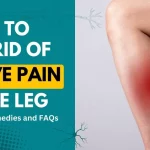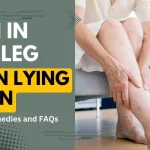Feeling pain in your legs when you stand up after sitting for a while is a common problem many people experience. This type of leg pain, sometimes referred to as “getting up leg pain,” has several potential causes. Fortunately, there are also many effective ways to prevent and treat this uncomfortable sensation. In this comprehensive guide, we’ll explore the various reasons you may feel leg pain when standing up from sitting. We’ll also provide tips on relieving this pain through stretches, exercises, lifestyle changes, and when to see a doctor. Additionally, we’ll answer some frequently asked questions about this topic.
Causes of Leg Pain When Standing Up From Sitting
There are several possible explanations for why your legs hurt when you stand up after sitting:
Poor Circulation
The most common cause of getting up leg pain is compression of the blood vessels in your legs while sitting, which restricts circulation and oxygen flow. When you stand up, the sudden movement causes blood to rush back into your legs, which may result in an aching or cramping sensation. This is especially common if you cross your legs while sitting.
Muscle Stiffness
Sitting for extended periods can cause your leg muscles, such as your hamstrings and quadriceps, to stiffen up. When you go to stand, these tight muscles have to suddenly stretch and move, which may cause pain. This discomfort is essentially your muscles protesting and saying they don’t want to move yet!
Nerve Compression
Having your legs bent at the knees and hips while sitting can put pressure on the sciatic nerve, which runs down the back of each leg. The sciatic nerve can get compressed or pinched, leading to sciatica pain and numbness that you’ll feel when standing up.
Arthritis
Osteoarthritis or inflammatory types of arthritis that affect the major joints in your legs, like your hips or knees, can cause pain when you change positions. The act of standing up from sitting requires these arthritic joints to move and bear weight, which aggravates joint pain.
Spinal Issues
Problems with your lower spine, such as a herniated disc, spinal stenosis (narrowing of the spinal canal), or degenerative disc disease, can pinch nerves that run down your legs. Like sciatica, this nerve irritation causes shooting pains and numbness, which may flare up when standing up.
Aging
As we get older, the cartilage and fluid between our joints starts to break down, making our joints less cushioned. This age-related wear and tear leads to more bone-on-bone grinding. Consequently, older adults are more prone to getting up leg pain due to general stiffness and arthritic changes.
Effective Remedies and Treatments for Leg Pain When Standing Up
The good news is that getting up leg pain can often be treated and prevented without the need for medical intervention. Here are some simple and effective remedies:
Stretching
Gentle stretching when sitting and before standing can help reduce muscle stiffness in your hamstrings, quadriceps, hips, and calves. Try to take a standing or walking break at least once an hour.
Exercise
Low-impact exercises like walking, swimming, or cycling can keep your muscles flexible and joints mobile. Stronger leg muscles through weight training may also improve stability. Just don’t overdo high-intensity workouts.
Massage
Massaging your legs while sitting or using a foam roller on sore spots before standing can loosen tight muscles. Massage may also improve circulation.
Compression Socks
Wearing snug (but not too tight) compression socks encourages better blood flow in your legs when sitting and standing. Compression socks gently squeeze your lower leg muscles to push blood back to your heart.
OTC Medication
For temporary relief, over-the-counter pain relievers like acetaminophen, ibuprofen, or aspirin can ease muscle aches and arthritis flare-ups that contribute to getting up leg pain.
Topical Pain Relievers
Applying over-the-counter creams containing menthol, camphor, capsaicin, or other analgesics directly where it hurts may numb and soothe leg pain when standing up.
Posture Correction
Pay attention to proper posture and ergonomics when sitting to avoid slouching and crossing your legs, which can restrict blood flow and pinch nerves. Support your lower back with a small pillow or rolled-up towel. Sit in a chair with your knees at hip level or use a footrest to avoid compressing your sciatic nerve. Get up and move around periodically.
Joint Protection
Those with arthritis may benefit from using a cane or wearing knee braces and low-heeled supportive shoes that reduce joint strain when standing. Losing excess weight also takes pressure off your hips, knees, and feet.
When to See a Doctor
In most cases, getting up leg pain resolves on its own or with conservative home treatment. But you should make an appointment with your doctor if your leg pain:
- Is accompanied by swelling, redness, warmth, or tenderness in the leg
- Persists for more than two weeks despite home treatment
- Worsens over time
- Spreads down to your calf or foot
- Is associated with numbness, tingling, or weakness in your leg
- Occurs along with lower back pain
- Happens without a clear trigger or when lying down
Seeking timely medical evaluation can determine if your leg pain stems from a more serious issue like a blood clot, Varicose veins, or nerve damage that requires specialized care. Diagnostic tests may include an ultrasound, MRI, or nerve conduction study. Treatment may involve prescription medications or therapies like steroid injections.
Frequently Asked Questions
Here are answers to some common questions about leg pain when standing up from sitting:
Why do my legs hurt when I stand up, but not when I sit down?
Standing up requires your leg muscles to contract suddenly to lift you up against gravity from a seated, bent position. This rapid motion can pinch nerves and strain muscles that have tightened up from sitting. Sitting down is a less jarring movement.
Is getting up leg pain a sign of something serious?
Most of the time, some muscle soreness when you stand after sitting is harmless, especially if it goes away quickly. But severe or persistent pain that arises without explanation or happens at night warrants medical evaluation to rule out dangerous clots, arthritis, or nerve damage.
How can I prevent pain from standing up?
Frequently change positions, stretch your legs, and take standing breaks to avoid leg stiffness while sitting. Exercise regularly, use proper posture, and manage your weight. Compression socks and arthritis aids like canes can also help take pressure off your legs.
How long does getting up leg pain usually last?
For the average person, the leg pain or discomfort that comes from standing up after sitting tends to resolve within 30 seconds as circulation improves and muscles loosen up. If pain persists for many minutes or makes it difficult to walk, consult your doctor.
Will massage help leg pain when standing up?
Yes, massage is an excellent way to stimulate blood flow and relax tight muscles that contribute to getting up leg pain. Even just self-massaging your calves and thighs when sitting and before standing can make a difference.
Conclusion
Leg pain that emerges when rising from a seated position is a nuisance many adults face. Typical culprits include poor circulation, tense muscles, compressed nerves, and joint problems like arthritis. Thankfully, basic stretching, exercise, compression garments, posture fixes, and massage are simple, effective solutions in most cases. But severe or recurring pain warrants medical care to check for an underlying condition. With the right prevention tactics and treatments, you should be able to manage troublesome getting up leg pain.



